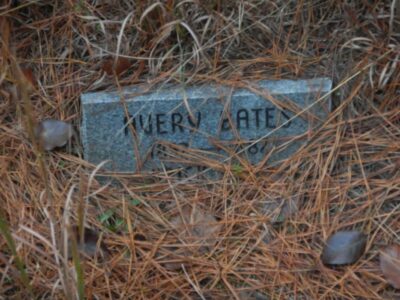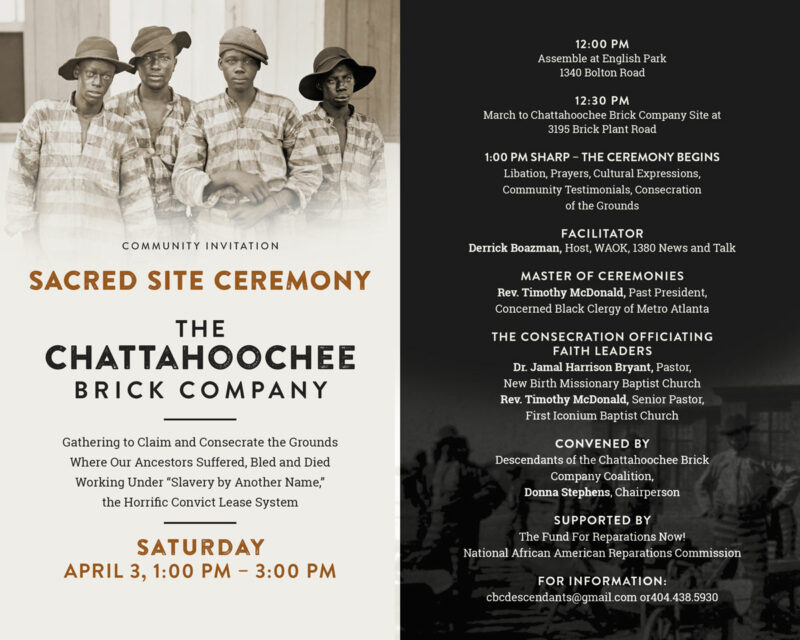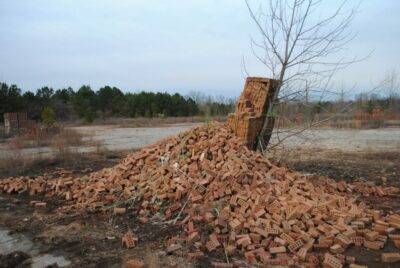Grassroots memorialization in Atlanta, Georgia: A conversation with the leader of the Chattahoochee Brick Company Descendants Community
31 March 2022 – Adina Langer and Donna Stephens
Editor’s Note: On December 6, 2021, the Atlanta City Council adopted legislation to purchase the former site of the Chattahoochee Brick Company (CBC) from the Lincoln Terminal Company, a corporation specializing in fuel transportation. The site had been leased by Norfolk Southern Railway, which had abandoned plans to use the location as a train-to-truck terminal facility when a coalition of local organizations—including Groundwork Atlanta, Proctor Creek Stewardship Council, West Atlanta Watershed Alliance, Riverwalk Atlanta, and others—protested this planned use. In addition to citing environmental concerns, the protestors focused on the history of the Chattahoochee Brick Company. Founded in 1878 by former Atlanta Mayor James W. English, the company was notorious for its extensive use of convict lease labor, which reproduced conditions for workers like those experienced during antebellum slavery in the United States. The history of the site was made famous in Douglas Blackmon’s 2008 Pulitzer Prize-winning book Slavery by Another Name: The Re-Enslavement of Black Americans from the Civil War to World War II (adapted as a PBS documentary in 2011). With the preservation movement gaining momentum, the National African American Reparations Commission organized a Sacred Site Ceremony to “claim and consecrate the grounds” of the CBC on April 3, 2021. Nine months later, History@Work editor Adina Langer discussed the process that led to this moment, and the future of the site, with Proctor Creek Stewardship Council co-chair, and leader of the Chattahoochee Brick Company Descendants Community, Donna Stephens.
Adina Langer: Can you please tell me about when you first learned about the history of the Chattahoochee Brick Company (CBC)?
Donna Stephens: As a native Atlantan, I have been aware of the CBC site my entire life. It was a source of employment. I had cousins who worked there in more recent times. Ownership had changed, but the people still called it CBC. I did not know about its horrific history until my sister and I viewed Douglas Blackmon’s documentary, Slavery by Another Name. We became very curious about the site after viewing the documentary. We were shocked and amazed that no one had ever shared this information with us. Our board membership with Groundwork Atlanta gave us information about the proposed industrial use of the site. The history compelled me to do something.

Grave marker for Avery Bates (1857-1887), a victim of the convict leasing system. The marker was placed by Bates’ family after they read Richard Becherer’s book, Bricks and Bones. Photo taken by Scape Studio for Chattahoochee Riverland in December 2018.
Langer: How did the Descendants of the Chattahoochee Brick Company Coalition (CBCDC) come into being? What’s the relationship between this coalition and the Proctor Creek Stewardship Council (PCSC)?
Stephens: The CBCDC came into formal existence one year ago when the National African American Reparations Commission offered their assistance. It is important to note that CBCDC has been a network of various people, organizations, and groups for years. Over the years I have relied on the support of many. This collection of advocates has fought strongly for the preservation of the CBC site. The Proctor Creek Stewardship Council was one of the first organizations that supported me with the CBC site. I have been a steward for years and currently serve as a co-chair and Community Engagement chair for PCSC. When I shared the news about the CBC site with PCSC they were very interested. Proctor Creek is one of the main borders of the site.
Langer: Now that the Atlanta City Council has passed legislation in support of the future purchase and restoration of the land currently owned by Lincoln Terminal Company, what are possible next steps for the site? What are the potential future uses of the site currently being debated by members of the Descendants’ Coalition?
Stephens: The Coalition has a mission statement. The CBCDC is committed to the restoration and preservation of the Chattahoochee Brick Company site for its uniquely sacred historical and educational value with an environmental justice approach. The City of Atlanta has been quiet about the CBC site plans. Former Mayor Bottoms was/is a strong advocate for the CBC site. This 75-acre site as a green space or park would be a welcome addition to the currently overly industrialized area. People have suggested a wide variety of things. Of course, affordable housing is at the top of the list of suggested uses of the site. 75 acres sounds like a lot; however, there are limits. The area has been over-industrialized for years. The air, water, and soil continue to be subjected to pollution. Floodplains exist on the site. What kind of remediation would be needed? Is it a brownfield? How much of a cleanup is needed? We are gathering ideas and hope to have plans soon. Atlanta has a new mayor. We hope that Mayor Andre Dickens will continue the effort to preserve and restore the CBC site. We would like to see a memorial and museum on the property. It is important to note that we must be careful in our visioning for the site. Disturbing the current ecosystems could be an environmental nightmare. I would love to see an inventory completed on the wildlife and aquatic life there. The plants also need to be studied. But the most important study would be an archaeology study of the site. The very history of CBC tells us people lived and died there. To truly honor our ancestors is to give them a proper burial and memorial. This has to occur first.

Community Invitation for a Sacred Site Ceremony for the Chattahoochee Brick Company that was held on April 3, 2021. Courtesy National African American Reparations Commission and Chattahoochee Brick Company Descendants Community.
Langer: This project has been supported by the National African American Reparations Commission and the Fund for Reparations Now. As you see it, what is the relationship between a potential memorial to victims of the convict leasing system and the concept of reparations?
Stephens: NAARC addresses ten arguments for reparations. [These include an apology and establishment of a Maafa institute, repatriation, land, funds, health and wellness, education, housing and wealth generation, information and communications infrastructure, sacred sites and monuments, and repairing damages of the criminal justice system.] In constructing a memorial on the CBC site, it both recognizes argument nine on creating sacred sites that forefront Black histories and point ten in recognizing the participation of the CBC in histories of incarceration. Victims of convict leasing suffered horrible fates there. A number of these victims (men, women, and children) paid the ultimate price by dying there. Most people do not know about convict leasing. It is important that we share this chapter of history with others. We are in the planning stages for community feedback. Because of COVID restrictions, public gatherings have been an obstacle.

Bricks at the former site of the Chattahoochee Brick Company. Photo taken by Scape Studios for Chattahoochee Riverlands during a site visit that took place in December 2018.
Langer: What do you think that public history practitioners should learn from the efforts of the Descendants of the Chattahoochee Brick Company Coalition and the Proctor Creek Stewardship Council?
Stephens: I think that the lesson learned here is that you never give up on what is right. We did not get here overnight. It took a great amount of tenacity to stay on course. I personally had to leave my comfort zone many times and I still find myself leaving my comfort zone. You must leave the shore to get to the other side. And that the time is always right to do the right thing.
~Donna Y. Stephens is an Atlanta native. She is a product of the Atlanta public school system. Donna is a Georgia State University alumna where she majored in Applied Sociology with a concentration in Family & Community Services. Her career path is filled with positions in the public sector working with the youth in a variety of ways. Donna followed her heart and became more involved in her community. Donna is a member of many environmental groups. Her experiences include US EPA Environmental Justice Academy. A heavy commitment to worthy causes aided Donna in raising awareness about convict leasing. She founded the Chattahoochee Brick Company Coalition and serves as chair. Her community involvement ranges from volunteer efforts in non-profit and grassroots organizations locally and nationally. Most recently she was highlighted as a Water Warrior and featured in the Atlanta Journal-Constitution as a part of their 2022 Black History Month. In her spare time, Donna enjoys reading and spending time with family and friends.
~Adina Langer is a co-lead editor of History@Work and has served as the curator of the Museum of History and Holocaust Education at Kennesaw State University since 2015. You can follow her @artiflection and find her online at www.artiflection.com.




This article is good source of information.